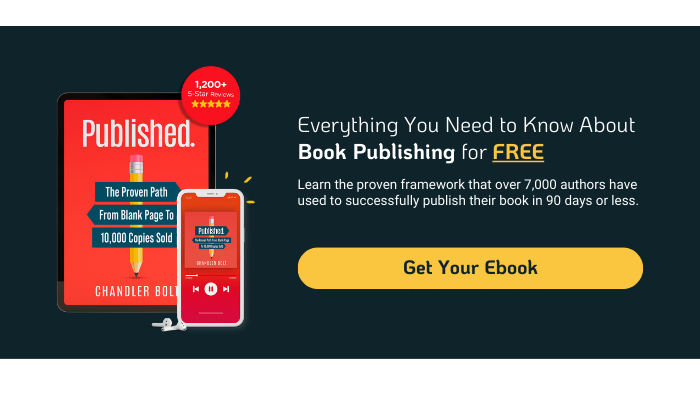How to Get an ISBN Number for a Self-Published Book & Answers to the Top 35 FAQs
Figuring out how to get an ISBN number for a self-published book may sound scary, but it’s actually more simple than many authors think!
If you’re self-publishing a printed book, the best action you can take is to get your own ISBN as a self-published author.
Regardless if a book was self-published or traditionally published, every printed book needs an ISBN, and securing this number is a big step in your publishing endeavors.
But, many writers that are just starting their journey on becoming an author still have a lot of questions around this topic.
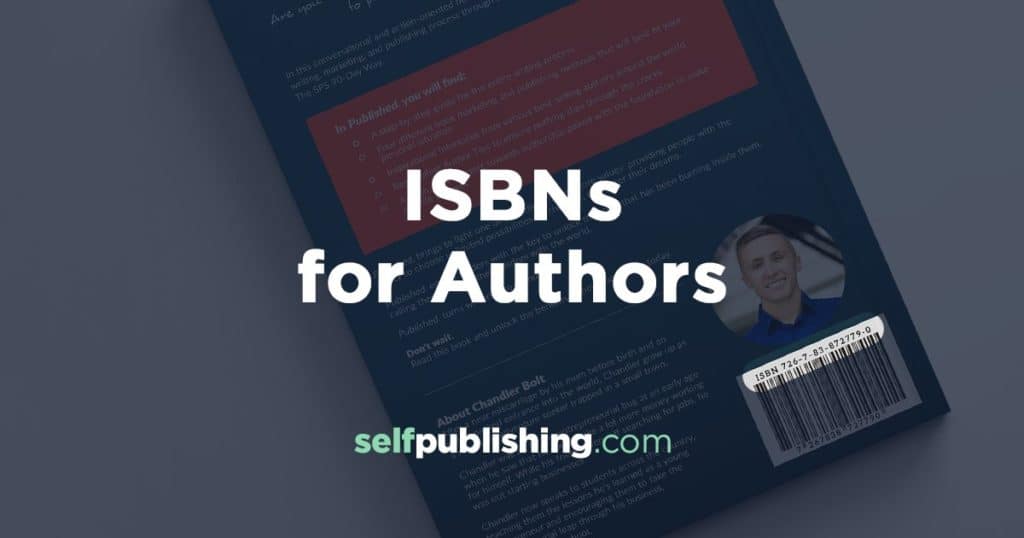
Questions like… How do you get an ISBN number for a self-published book? Do I buy one or just get it for free through KDP or an aggregator? How much does an ISBN cost? Are ISBNs for big-name publishers only?
And a whole lot more!
In this post, we want to answer the commonly asked questions around ISBNs for self-published books, as well as everything else you need to know to buy, register and imprint your ISBN.
Now, before you start thinking about ISBN numbers, let me ask you this: Do you have a book ready to publish? If not, you can start preparing for an ISBN now, but you’ll definitely want to finish writing your book first!
This comprehensive list of questions covers the basics—and then some—of ISBNs. The best part is, you can scan through these questions on ISBNs in just under 20 minutes.
As you read through these questions, we encourage you to open up these two websites:
#1 – MyIdentifiers
#2 – ISBN International
There is a wealth of information on those sites regarding ISBNs [including how to buy] that we will cover while going through these questions.
1. What is the ISBN of a book?
ISBN, which stands for International Standard Book Number, is a 13-digit number that’s used as a unique identifier for books, including a specific book, a book edition, or any other book-like products. An ISBN number can be used to identify the book’s code digits, language, publisher, book title, edition, and format. The ISBN is used internationally and requires a different number for each version of the book.
ISBNs are necessary for printed books that are distributed in retail bookstores, libraries, and wholesale companies. ISBN numbers are not required for eBooks, and for books that will not be available in stores or libraries.
2. Can self-publishers get an ISBN?
A self-publisher is still a publisher, so yes, you just apply for an ISBN like anyone else. Refer to myidentifiers.com.
3. How to get an ISBN number for a self-published book?
As a self-publisher, the method to obtain an ISBN is the same as any other publisher and/or author. You can purchase an ISBN or obtain one for free through your self-publishing platform.
Here are two ways to get an ISBN for a self-published book:
#1 – Purchase an ISBN from your regionally-accepted source.
#2 – Receive a free ISBN from your self-publishing platform.
We’ll cover these steps in more detail further down this post, since you will follow the same process to get an ISBN for a self-published book.
If you’re a resident of the United States, you can purchase an ISBN through Bowker.
Or, you can obtain one for free through Amazon’s KDP. If you upload to Draft2Digital or SmashWords, they will provide you with one for free.
But, as we will mention further along in this post, be sure you have only one ISBN number registered to your self-published book and not multiple numbers spread out over various platforms.
4. Were ISBNs originally created for books?
No. In the days of WW2, MI6 recruited a young mathematician named Gordon Foster to work as a codebreaker, where he scanned millions of numbers looking for patterns in the code used by the Japanese military.
Decades later, when the book industry needed a standardized tracking program to organize the growing number of titles being published every year, Gordon Foster was approached by British retailer WH Smith, to write a report on how to create such a system.
This report ultimately led to the ISBN system that is now used worldwide.
5. How many numbers should an ISBN have?
Due to the large volume of eBooks now published every year, since 2007, the ISBN is a 13-digit number. But before that, for over thirty years, ISBNs were 10 digits long.
Older ISBN numbers with only 10 digits can now be converted into a 13-digit code with the ISBN conversion tool from Bowker.
6. What is an ISBN number used for?
An ISBN is used to identify each published book and each edition of the same book. ISBN also identifies the publisher of the book.
It is the standard ID number used to identify books by booksellers, libraries, book wholesalers, and distributors.
7. What do the ISBN numbers really mean?
You can tell a lot about a book, its author, and the publisher by knowing how to read the ISBN number.
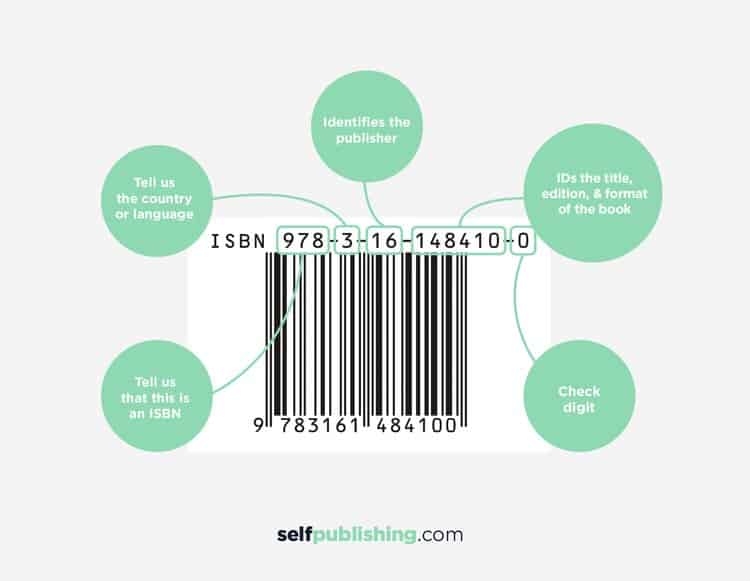
The 13 digit ISBN number is broken up into 5 parts that identify the following:
#1 – Book Code Digits: The first three digits “978” indicate that this string of numbers is for an ISBN.
#2 – Language of the Book: The language for an English version is identified with an “0” or “1”. You can reference this complete list at the International ISBN Agency.
#3 – Publisher
#4 – Book title, Edition, and Format: The six-digit series represents the title of the book.
#5 – Check Digit: “0” is. the last digit and is known as the “check digit”. This number is mathematically calculated as a fixed, single digit.
8. How do I find the ISBN number of a book?
There are several ways to look up the ISBN number of a book, both on the book and online.
Here’s how to find the ISBN number of a book:
#1 – Check the back cover of the book, and look for the ISBN near the publisher’s barcode.
#2 – Look on the copyright page located in the front of the book near the title page.
#3 – Search for the book’s ISBN online using the author or title on ISBN Search.
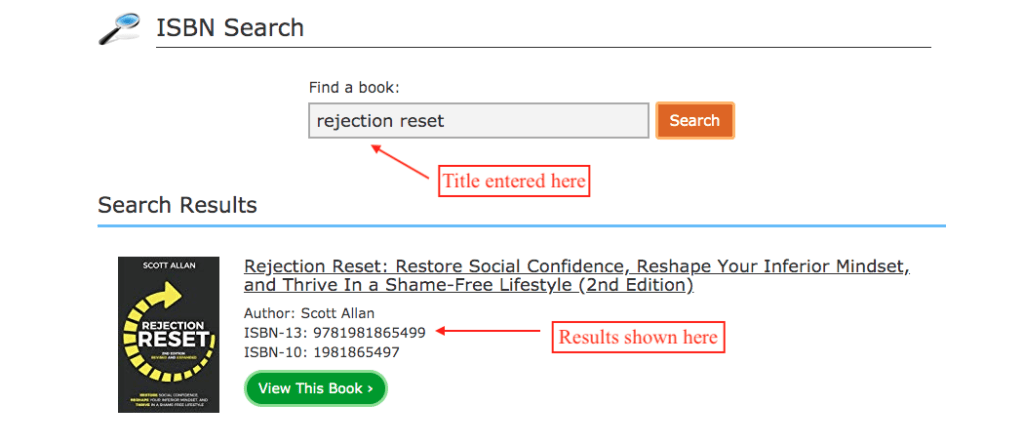
9. Should a self-published author get an ISBN?
Yes, your self-published book should have an ISBN if you plan to sell your printed book in bookstores and libraries.
If you plan to sell your printed book through Amazon self-publishing or online retailers and book aggregators, you will need an ISBN. For print books published through KDP, the ISBN can be provided free through Amazon.
It doesn’t matter if you are writing a children’s book or a nonfiction book, your printed book needs an ISBN if you envision it in the bookstore or on the shelves of your local library.
There are limitations to this. For eBooks, an ISBN is not needed, except for certain exceptions, like if you publish through digital online distributors/aggregators.
For example, Draft2Digital requires your book to have an ISBN. Although they will provide you with an ISBN for free, we recommend buying your own, for reasons explained further down in this post.
Reasons to get an ISBN for a self-published book:
#1 – If you want your book sold in bookstores and retail stores
#2 – If you want your book circulated in libraries
#3- If your book will be printed (not solely an eBook)
#4 – If you plan to use a book aggregator company to publish
10. If I get an ISBN, does that mean my book is copyrighted?
No, ISBN is administered by a private company for the use of the international book trade, while copyright is administered by the Library of Congress and is an extension of intellectual property law.
11. Does a book have to be published to have an ISBN?
No, you can obtain an ISBN for your book even if it is not published yet.
ISBNs are issued to publishers, who then assign them to individual books. This can be done at any time, even before the book is written.
12. How do I buy an ISBN in the US? If I live outside the USA?
ISBNs are issued based on location.
If you live in the United States, you can purchase an ISBN through Bowker, which is the only company authorized to administer the ISBN program in the United States.
Here are the steps to buy an ISBN if you live in the United States:
#1 – Go to myidentifiers.co
#2 – Click on “ISBN
#3 – Select the quantity you’d like to purchase
#4 – Click “Buy Now”
#5 – Complete checkout
For international authors, you can visit the International ISBN Agency.
In Canada, where the ISBNs are issued for free, you can visit the ISBN Canada—Library and Archives website.
Living in the UK, Ireland, or a British Overseas Territory, check out Nielsen ISBN Store.
| If you live in…. | Go to: |
| United States | myidentifiers.com |
| Canada | ISBN Canada—Library and Archives |
| U.K., Ireland, or a British Territory | Nielsen ISBN Store |
| Anywhere else internationally | International ISBN Agency |
Note: While ISBNs are assigned locally, you can use them internationally.
13. Can I register my ISBN once it has been approved?
Yes, you can register your ISBN number once it is approved.
Once you have received your number, you should register it at Bowkerlink. Bowker hosts about 12 million international titles and registration with them places your book in their massive bibliographic database.
14. Do I need a different ISBN for every country the book is published in?
No, you don’t need an ISBN if the book is available in other countries and appears in the same format and language.
You do need an ISBN for every format and edition of the book. This includes publications in different languages. Refer to the International ISBN Agency for a list of language codes.
15. For what reasons would you have to assign a new ISBN to a book?
ISBNs will need to be changed if certain changes are made to your book.
There are 6 main reasons why you’d have to change the ISBN:
#1 – The book is printed in Large Print. Remember, every variation/version requires its own ISBN.
#2 – The book is published in a foreign language. This would be considered a different format and needs a separate ISBN.
#3 – If additional material is added to the book. For example, several new chapters are added. This could also mean the book is relaunched as a 2nd edition.
#4 – If the title/subtitle is changed.
#5 – If changes are made to the binding.
#6 – If the book is published in another size. So, for a 5×8, 5.5×8.5 or 6×9, each of these would require a separate ISBN.
Essentially, any changes to the book that makes it appear as a “different product” would require a new ISBN.
16. What changes can I make to the book that would not require a new ISBN?
There are several things you can make alterations to that will not need new ISBNs.
Changes that don’t require a new ISBN:
#1 – Changing the book price
#2 – Creating a new cover design
#3 – Switching over to another distributor or printer
#4 – Small corrections to the content. This could be correcting grammatical errors or improving the writing of several paragraphs.
| Changes Made to Book: | New ISBN needed? |
| Printed in a variation, such as large print | Yes |
| Published in a different format | Yes |
| Published in a different language | Yes |
| Additional content added, like more chapters | Yes |
| Title and/or subtitle changed | Yes |
| Binding changes | Yes |
| Published in a new size | Yes |
| Increase or decrease book price | No |
| Create a new cover design | No |
| Switch to a new distributor or printer | No |
| Minor edits and corrections made to content | No |
17. What is the Bookland EAN Barcode?
According to Publisher Services, an official US ISBN Agency Partner:
“An EAN—which begins with the Bookland prefix 978—is called a Bookland EAN code and is used on books and book related products internationally. The Bookland symbol is the barcode of choice in the book industry because it allows for encodation of ISBNs (the numbers publishers use to identify their products).”
Since an ISBN is unique to one particular title (or product), the corresponding Bookland EAN symbol is a title-specific marking that is unique for that title.
For example, if a title is available in hardcover, softcover, and as an e-book, three unique ISBN Bookland EAN bar codes are required.
18. How much does an ISBN cost?
The less expensive option is to buy one single ISBN on Bowker. However, if you ever publish another edition of your book, or another book entirely, you will need more than one ISBN.
In that case, buying the 10-back bundle would be the best deal by far.
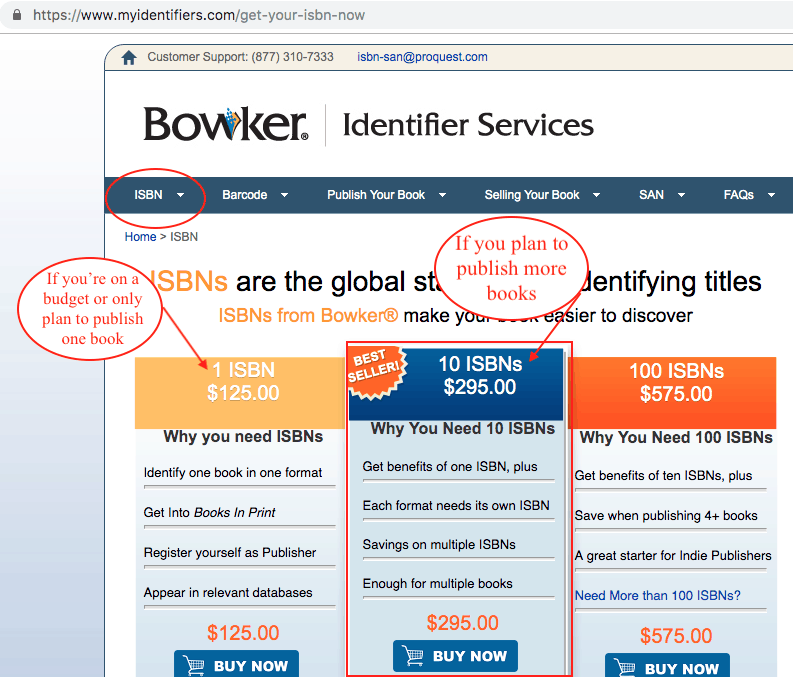
The going rate for a single ISBN costs $125, while 10 ISBNs cost $295, 100 ISBNs cost $575, and 1000 ISBNs cost $1500.
Note that these prices are based on the price listings at Bowker for those living in the United States.
For ISBNs purchased internationally, prices do vary (and are often cheaper).
19. How many ISBNs should I buy?
Obviously, how many you buy depends on your publishing goals. If you are a busy author publishing a new book every 4-6 weeks, in multiple languages and several formats, I would go with 100 ISBNs.
Remember: ISBNs do not expire.
And, consider if you use 3 ISBNs for each book in one language, you could use up a block of ten very quickly if publishing regularly.
The number depends on if you are assigning an ISBN to your eBook as well as printed versions. Although eBooks are not, at this time, required to have an ISBN, it does look more professional. This is your choice, of course.
If you write one book and you don’t have plans to do anymore, one ISBN will probably do. But for career authors, think about the long-term game plan.
20. How to get an ISBN for free?
If you live in Canada, ISBNs are issued for free. If you live in the United States, you can get your book’s ISBN for free through your self-publishing platform, such as Amazon and Draft2Digital, which will provide you with an ISBN at no cost.
21. What reasons would a self-published author not need an ISBN?
If you are only publishing an eBook, and you have no plans to write and publish anything more, you won’t need an ISBN.
Or, if you are happy to publish through Amazon KDP only (print edition) and not use other online retailers, you can request Amazon provide you with a free ISBN.
22. Can I re-use my ISBN?
No. Once assigned to a book, an ISBN can never be reused. If you republish your book or publish it in another format, ISBNs are non-transferable. One ISBN per book only.
23. Are ISBN numbers transferable across different formats?
No. A single ISBN can be issued for each book only. In the case of paperback and hardcover versions, a separate ISBN is required. An eBook requires its own ISBN as well.
24. What are the advantages and disadvantages of getting a free ISBN?
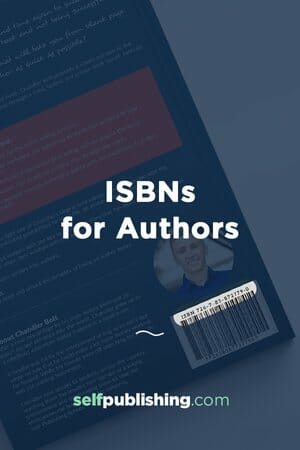
The main advantage is…it’s free. This can be convenient if you’re on a budget. Or, if it’s difficult to obtain an ISBN in the region you live in.
If you are in the U.S., you purchase through Bowker, or if you’re in the U.K., you purchase through Nielson. Both sites make it very easy to buy ISBNs.
Depending on your international location, you could go through a lot of red tape to get your number. But if you can, we recommend buying your own ISBN.
The disadvantage of receiving a free ISBN:
- You have to list Amazon (or the self-publishing platform) as the publisher along with other limitations.
- You could end up with several ISBNs for the same book, and this looks unprofessional. For example, you receive a different ISBN from Amazon, Draft2Digital and Smashwords.
- Free ISBNs are non-transferable. You can’t take your free ISBN from Amazon and use it with another retailer.
25. Do I need an ISBN number to get my book into libraries?
Yes. If you want to stock your book in libraries, you’ll need an ISBN that you purchased and registered.
The library market is huge and, if you are serious about expanding the distribution of your book, this is not an opportunity you want to pass up.
Again, a free ISBN will not do. The ISBN needs to be registered to a publisher – that would be you as the author (or your self-publishing company).
Overdrive is the biggest supplier of eBooks to libraries and has circulated over 105 million+ books to date to libraries.
26. Where does the ISBN number need to be printed on a self-published book?
You’ll print it on the copyright page, and it’s included in the Cataloging-in-Publication data block if you use one.
Otherwise, just print it on the copyright page and on the back cover as part of the barcode.
27. If I revise the inside content of a book, do I need to replace the current ISBN?
If you only make line edits or correct typographical errors and don’t make any substantial changes and/or additions to the text, you don’t need a new ISBN because it’s considered a reprint.
A new edition would contain a significant amount of new material, a major revision, or the addition of completely new chapters/sections. Anything that makes it a ‘new book’ is likely to create a new edition. Therefore, a new ISBN would be required.
28. If I just change the cover or the title of the book, do I need a new ISBN?
You can continue to use the same ISBN if the cover is changed. But if you change the title and/or subtitles and you will have to launch the print version of the book as a new title again, as this is recognized as a different book.
29. What is the difference between the ASIN and ISBN number?
ASIN is a number used by Amazon to identify products, whereas ISBN is the universal number for identifying a book.
ASIN numbers are used by Amazon to manage identify the products they are selling. It’s a 10-character alphanumeric unique identifier that’s assigned by Amazon.com only.
An ASIN is not the same as an ISBN. You can only use it with Amazon. If you want to sell through other platforms—or in brick and mortar stores— you’re going to need an ISBN.
You can find this ASIN on your book page. In your browser, the Amazon ASIN will be after the product’s name and “dp”. The next place to find this is in your book or product details area of your book page.
Note: ASIN numbers are exclusive to Amazon only and are non-transferable, and cannot be used in place of an ISBN.
30. Is it acceptable to have several ISBNs for the same book?
No, you really don’t want several ISBNs for your book. This can become a tangled mess and looks unprofessional. But this commonly occurs when several retailers issue free ISBNs for the book.
Online aggregators such as Draft2Digital and Smashwords free ISBNs are not transferable so, if they are issuing a free one, it is exclusive to that site only. This is the same with Amazon.
Best solution: Buy your own ISBN. When you buy your own, the same number is used for that format no matter where it is published.
31. Is an ISBN the same as a barcode? If not, what are the differences?
The ISBN and barcode are different. Although both are found on the back of the book in the same place, they both fulfill a different function.
The ISBN is found above the barcode on the back of the book. We already know the different parts of an ISBN.
The barcode includes extra information such as:
- the book’s fixed price and;
- the currency it’s being sold in.
The barcode is a representation of the ISBN in a form that can be identified by scanners. The bar code might also have other information embedded in it, like the price of the book and the currency in which it is priced.
The standard barcode is known as the EAN (European Article Number) barcode, and your barcode must be in this format to sell your book in bookstores.
Here are some facts about barcodes and ISBNs according to Bowker:
- A barcode is not an ISBN. It’s a graphical representation of your book’s ISBN and price.
- To use a barcode, you’ll need your book’s ISBN and pricing information.
- You can purchase and download a barcode after you’ve created an account at MyIdentifiers.com.
- You can store your barcodes for future use at MyIdentifiers.com.
- Make sure you enter the correct price on the barcode. Once the barcode is generated the price cannot be changed.
Similar to an ISBN, does a barcode last for life? Would it ever change?
If you change the cost of your self-published book, you will need a new barcode. The ISBN, however, does not expire, and does not need to be changed if you change the price.
32. How can I find my book’s ISBN number?
You can easily find the ISBN of a book through a quick online tool.
To look up your ISBN number, follow these steps:
#1 – Visit the website https://isbnsearch.org/
#2 – Enter the author name, book title, or ISBN.
#3 – Click “Search” and the related books will appear in the results.
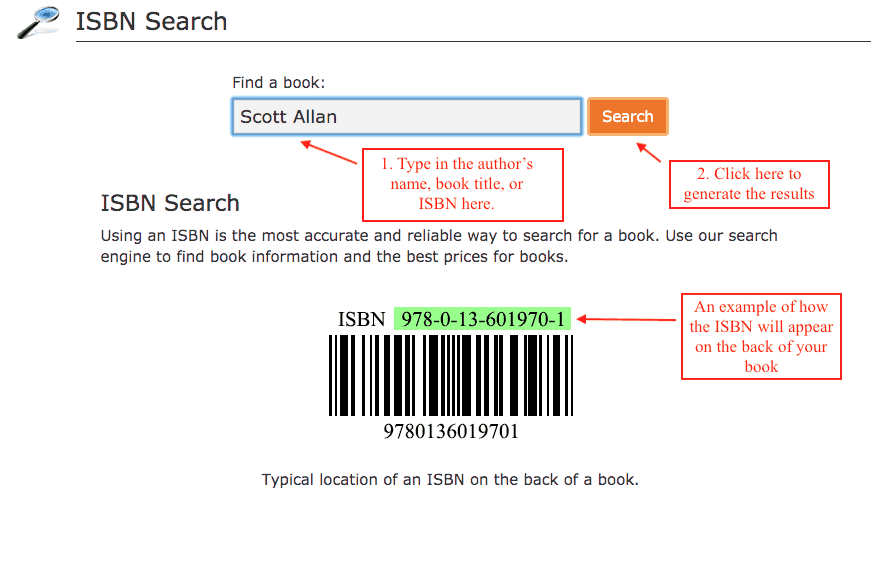
33. Is the ISBN and barcode sold separately?
Yes, the ISBN and barcode are sold separately. But, the barcode cannot be purchased without the ISBN being bought first.
You need an ISBN to get a barcode, but you don’t need a barcode to publish a book.
Bowker offers an ISBN and barcode savings pack. It is a great value if you want to save some money and make it easier for setting up your ISBN and barcode together.
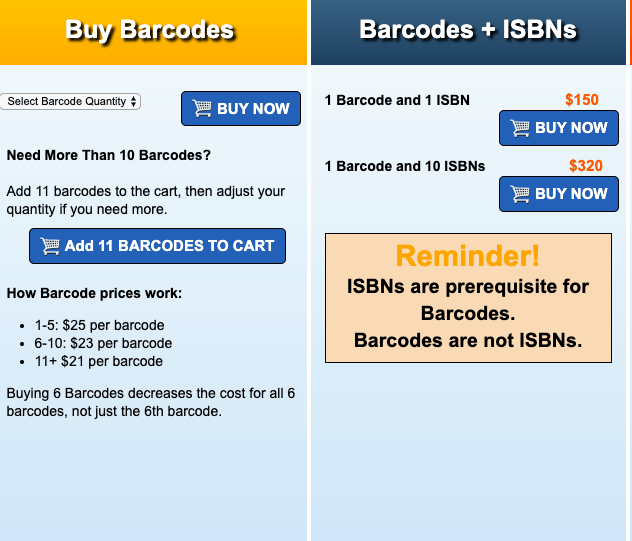
34. Should I use the “free” barcode generating tool to save money?
No, it’s not a good idea to use a free barcode generating tool and we do not recommend it.
Here’s why: Many free barcodes are created with unreliable bitmapped images that run the risk of not scanning when your book is being purchased. For reliability, pay for it through a reliable source. You won’t be saving money of the barcode can’t be scanned properly.
35. What are the best resources for finding out more about ISBNs and barcodes?
As we have mentioned throughout these questions, there are several best resources for finding out everything on ISBNs, including how to buy and set up for your book.
Additional resources for researching ISBNs:
- International ISBN Agency
- ISBN.org by Bowker
- Bowkerlink Publisher Access System
- Bowker Identifier Services
- U.S. Copyright Office
- ISBN Guides: Basic Information
- SmashWords ISBN Manager
- ISBN Canada: Library and Archives Canada
That’s it! You’ve reached the end of our frequently-asked-questions about ISBNs.
Now you know exactly how to get an ISBN number for your self-published book, why it’s important, and if you actually need it.


